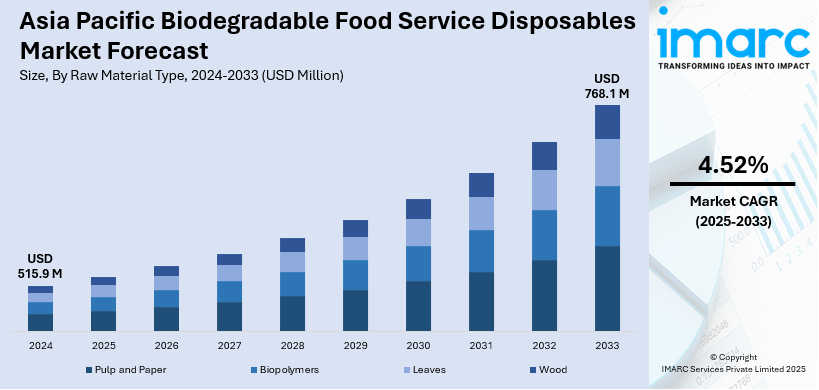
Asia Pacific Biodegradable Food Service Disposables Market Size, Share, Trends and Forecast by Raw Material Type, Product Type, Distribution Channel, and Country, 2025-2033
Market Overview:
The Asia Pacific biodegradable food service disposables market size reached USD 515.9 Million in 2024. Looking forward, IMARC Group expects the market to reach USD 768.1 Million by 2033, exhibiting a growth rate (CAGR) of 4.52% during 2025-2033.
|
Report Attribute
|
Key Statistics
|
|---|---|
|
Base Year
|
2024
|
|
Forecast Years
|
2025-2033
|
|
Historical Years
|
2019-2024
|
|
Market Size in 2024
|
USD 515.9 Million |
|
Market Forecast in 2033
|
USD 768.1 Million |
| Market Growth Rate (2025-2033) | 4.52% |
Biodegradable disposables are produced from naturally occurring materials like sugarcane fiber (bagasse), corn starch, wheat bran, areca nut sheaths, bamboo, and various leaves such as palm leaves and coconut coir. These disposables can be composted after degradation as the material releases valuable nutrients into the soil, making it fertile. In the Asia Pacific region, biodegradable food service disposables are gaining preference owing to the growing awareness among consumers about the harm that non-biodegradable disposables cause to the environment.

To get more information on this market, Request Sample
The Asia Pacific biodegradable food service disposables market is primarily driven by the expanding food and beverage industry. Along with this, changing lifestyles of the urban population have increased the percentage of people choosing on-the-go food and drinks, thereby propelling the demand for biodegradable disposables. Besides this, the growing trend of online food retailing has generated the need for environmentally sustainable food packaging solutions. Besides this, regional governments are undertaking initiatives to promote the use of biodegradable food packaging materials as a way of reducing waste. For instance, Chai Point, one of the largest organized tea retailers in India, introduced 100% biodegradable packaging, such as food boxes, plates and cutlery, in 2016.
Key Market Segmentation:
IMARC Group provides an analysis of the key trends in each segment of the Asia Pacific biodegradable food service disposables market report, along with forecasts at the regional and country levels from 2025-2033. Our report has categorized the market based on raw material type, product type, and distribution channel.
Breakup by Raw Material Type:
- Pulp and Paper
- Biopolymers
- Leaves
- Wood
Breakup by Product Type:
- Cups
- Clamshells and Containers
- Plates
- Cutleries
- Others
Breakup by Distribution Channel:

- Business to Customer (B2C)
- Business to Business (B2B)
- Supermarkets and Hypermarkets
- Online Stores
- Others
Breakup by Country:
- China
- Japan
- India
- South Korea
- Australia
- Indonesia
- Others
Competitive Landscape:
The competitive landscape of the industry has also been examined along with the profiles of the key players.
Report Coverage:
| Report Features | Details |
|---|---|
| Base Year of the Analysis | 2024 |
| Historical Period | 2019-2024 |
| Forecast Period | 2025-2033 |
| Units | Million USD |
| Segment Coverage | Raw Material Type, Product Type, Distribution Channel, Country |
| Countries Covered | China, Japan, India, South Korea, Australia, Indonesia, Others |
| Customization Scope | 10% Free Customization |
| Post-Sale Analyst Support | 10-12 Weeks |
| Delivery Format | PDF and Excel through Email (We can also provide the editable version of the report in PPT/Word format on special request) |
Key Questions Answered in This Report:
- How has the Asia Pacific biodegradable food service disposables market performed so far and how will it perform in the coming years?
- What has been the impact of COVID-19 on the Asia Pacific biodegradable food service disposables market?
- What are the key regional markets?
- What is the breakup of the market based on the raw material type?
- What is the breakup of the market based on the product type?
- What is the breakup of the market based on the distribution channel?
- What are the various stages in the value chain of the industry?
- What are the key driving factors and challenges in the industry?
- What is the structure of the Asia Pacific biodegradable food service disposables market and who are the key players?
- What is the degree of competition in the industry?
Need more help?
- Speak to our experienced analysts for insights on the current market scenarios.
- Include additional segments and countries to customize the report as per your requirement.
- Gain an unparalleled competitive advantage in your domain by understanding how to utilize the report and positively impacting your operations and revenue.
- For further assistance, please connect with our analysts.
 Request Customization
Request Customization
 Speak to an Analyst
Speak to an Analyst
 Request Brochure
Request Brochure
 Inquire Before Buying
Inquire Before Buying




.webp)




.webp)












